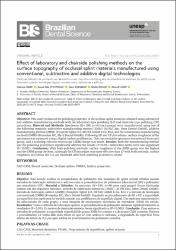| dc.contributor.author | Bilir, Halenur | |
| dc.contributor.author | Eyyüpoğlu, Suzan Eda | |
| dc.contributor.author | Karaman, Enes | |
| dc.contributor.author | Özcan, Mutlu | |
| dc.contributor.author | Lukic, Nenad | |
| dc.date.accessioned | 2023-08-11T10:34:48Z | |
| dc.date.available | 2023-08-11T10:34:48Z | |
| dc.date.issued | 2023 | en_US |
| dc.identifier.citation | Bilir, H., Eyyüpoğlu, S. E., Karaman, E., Özcan, M. ve Lukic, N. (2023). Effect of laboratory and chairside polishing methods on the surface topography of occlusal splint materials manufactured using conventional, subtractive and additive digital technologies. Brazilian Dental Science, 26(3). https://dx.doi.org/10.4322/bds.2023.e3873 | en_US |
| dc.identifier.issn | 2178-6011 | |
| dc.identifier.uri | https://dx.doi.org/10.4322/bds.2023.e3873 | |
| dc.identifier.uri | https://hdl.handle.net/20.500.12511/11308 | |
| dc.description.abstract | Objective: This study evaluated the polishing properties of the occlusal splint materials obtained using subtractive and additive manufacturing methods with the laboratory-type polishing (LP) and chairside-type polishing (CP) procedures. Material and Methods: Specimens (N=180, n=60 each group) were manufactured using one of the following methods: subtractive manufacturing method (SMM) (M-PM Disc, Merz Dental GmbH), additive manufacturing method (AMM) (Freeprint Splint 2.0, DETAX GmbH & Co. KG), and the conventional manufacturing method (CMM) (Promolux HC, Merz Dental GmbH). Following LP and CP procedures, surface roughness of the specimens was measured using a digital surface profilometer. One representative specimen was selected from each group, and a scanning electron microscope (SEM) image was made. Results: Both the manufacturing method and the polishing procedures significantly affected the results (P<0.01). Interaction terms were also significant (P[removed] | en_US |
| dc.description.abstract | Objetivo: Este estudo avaliou as propriedades de polimento dos materiais de splint oclusal obtidos usando métodos de fabricação subtrativos e aditivos com os procedimentos de polimento laboratorial (LP) e polimento em consultório (CP). Material e Métodos: As amostras (N=180, n=60 para cada grupo) foram fabricadas usando um dos seguintes métodos: método de fabricação subtrativo (SMM) (M-PM Disc, Merz Dental GmbH), método de fabricação aditivo (AMM) (Freeprint Splint 2.0, DETAX GmbH & Co. KG) e o método de fabricação convencional (CMM) (Promolux HC, Merz Dental GmbH). Seguindo os procedimentos de LP e CP, a rugosidade da superfície dos espécimes foi medida usando um perfilômetro de superfície digital. Um espécime representativo foi selecionado de cada grupo, e uma imagem de microscópio eletrônico de varredura (SEM) foi obtida. Resultados: Tanto o método de fabricação quanto os procedimentos de polimento afetaram significativamente os resultados (P<0,01). Os termos de interação também foram significativos (P<0,001). Conclusão: Com ambos os métodos de polimento, a rugosidade superficial do grupo AMM foi a maior e a do grupo CMM a menor. Embora o procedimento CP tenha sido mais eficaz do que LP com ambos os métodos, a rugosidade da superfície ficou abaixo do limite de 0,2 μm após ambos os procedimentos de polimento testados. | en_US |
| dc.language.iso | eng | en_US |
| dc.publisher | Universidade Estadual Paulista, Institute of Science and Technology of Sao Jose dos Campos | en_US |
| dc.rights | info:eu-repo/semantics/openAccess | en_US |
| dc.rights | Attribution 4.0 International | * |
| dc.rights.uri | https://creativecommons.org/licenses/by/4.0/ | * |
| dc.subject | CAD-CAM | en_US |
| dc.subject | Dental Materials | en_US |
| dc.subject | Occlusal Splints | en_US |
| dc.subject | PMMA | en_US |
| dc.subject | Surface Properties | en_US |
| dc.subject | CAD-CAM | en_US |
| dc.subject | Materiais Dentários | en_US |
| dc.subject | PMMA | en_US |
| dc.subject | Propriedades de Superfícies | en_US |
| dc.subject | Splints Oclusais | en_US |
| dc.title | Effect of laboratory and chairside polishing methods on the surface topography of occlusal splint materials manufactured using conventional, subtractive and additive digital technologies | en_US |
| dc.title.alternative | Efeito de métodos de polimento em laboratório e em consultório na topografia de superfície de materiais de splint oclusal fabricados usando tecnologias digitais convencionais, subtrativas e aditivas | en_US |
| dc.type | article | en_US |
| dc.relation.ispartof | Brazilian Dental Science | en_US |
| dc.department | İstanbul Medipol Üniversitesi, Diş Hekimliği Fakültesi, Protetik Diş Tedavisi Ana Bilim Dalı | en_US |
| dc.authorid | 0000-0002-1753-6747 | en_US |
| dc.authorid | 0000-0003-2861-9422 | en_US |
| dc.authorid | 0009-0003-6320-3358 | en_US |
| dc.identifier.volume | 26 | en_US |
| dc.identifier.issue | 3 | en_US |
| dc.relation.publicationcategory | Makale - Uluslararası Hakemli Dergi - Kurum Öğretim Elemanı | en_US |
| dc.identifier.doi | 10.4322/bds.2023.e3873 | en_US |
| dc.institutionauthor | Bilir, Halenur | |
| dc.institutionauthor | Eyyüpoğlu, Suzan Eda | |
| dc.institutionauthor | Karaman, Enes | |
| dc.identifier.scopus | 2-s2.0-85165951280 | en_US |
| dc.identifier.scopusquality | Q3 | en_US |



















